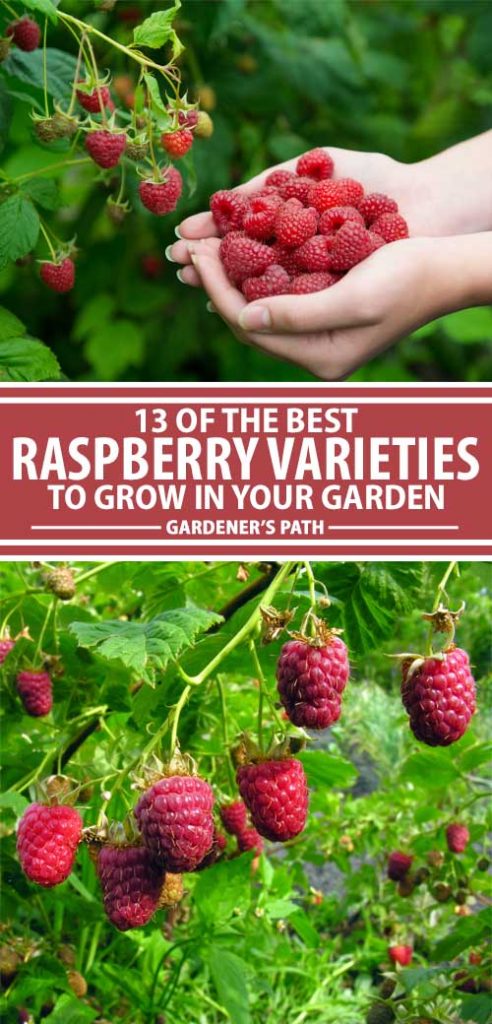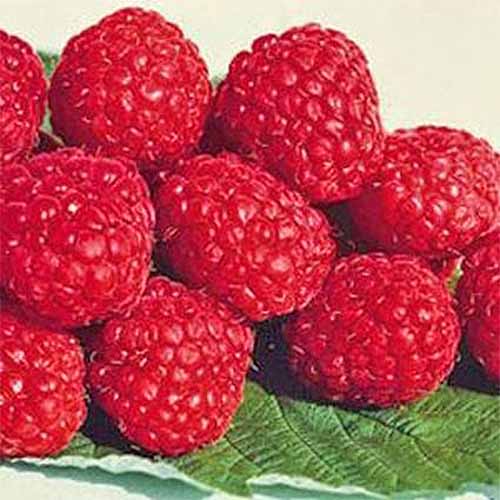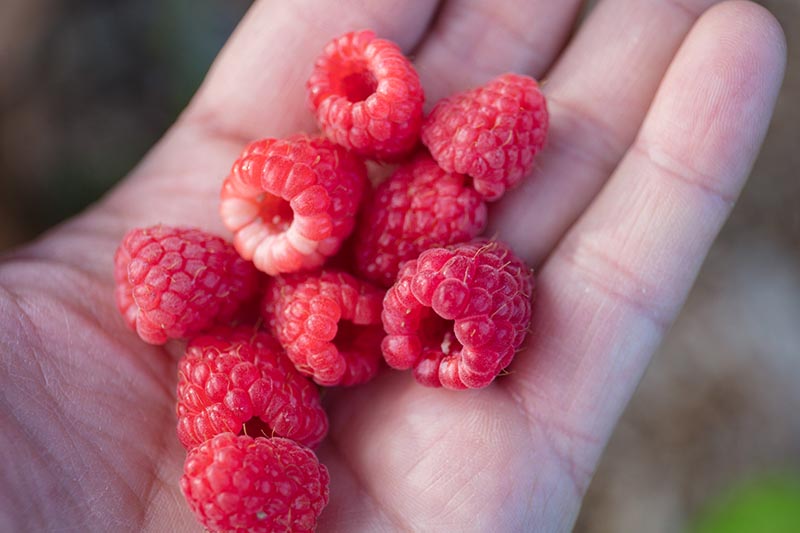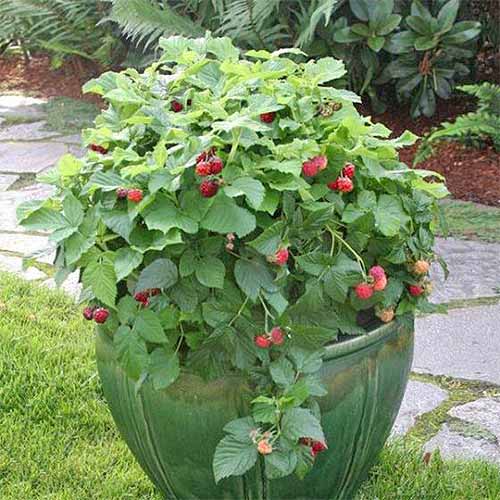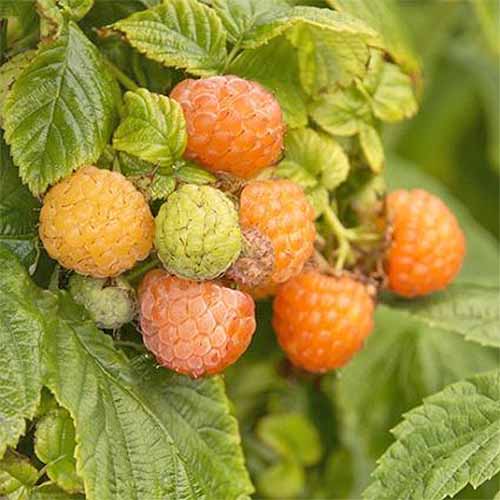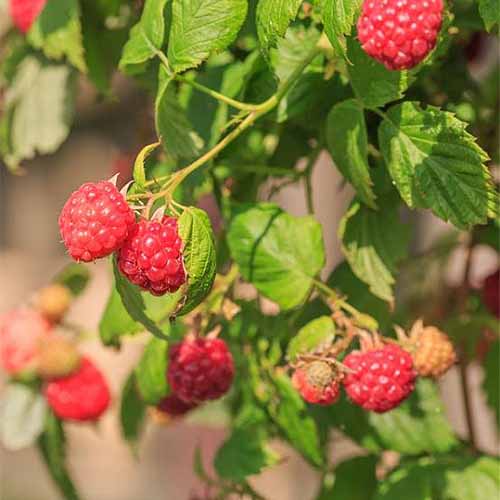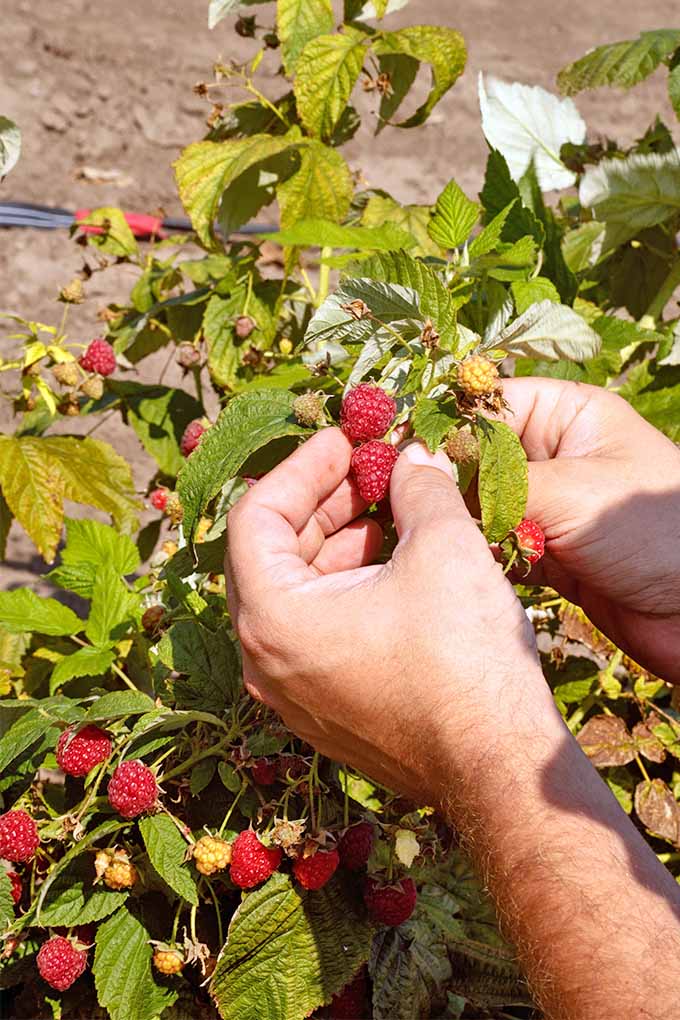But my mind goes first to memories of my childhood – those seemingly endless summer days filled with the sound of flip-flops and jelly shoes slapping hot asphalt, blowing bubbles and running through the sprinkler, pumping your arms to fly as high as you could on the swing set. That ozone smell through the screen door of a thunderstorm brewing in the distance, hunting for horseshoe crabs and building drip castles down the shore, splitting a grape two-stick popsicle with your best friend, and catching lightning bugs before bed. We link to vendors to help you find relevant products. If you buy from one of our links, we may earn a commission. Unless you live in the desert or the extreme frozen north, you can grow raspberries. Red, yellow, black, or purple, there’s something for just about everyone. And whether you’re looking for an everbearing crop that will produce multiple harvests, or a big batch for canning that’s ready to pick all at once, there’s a cultivar for you. If you’re gardening in a small space, some varieties make excellent container plantings, and self-pollinators will still produce fruit if you only have room for one plant. There are cultivars that require a lot of pruning and tending, while others can still thrive if you like to take a more hands-off approach to gardening. Best of all, once established, most types of raspberry will continue to produce fruit for 10 to 15 years, if not longer. Dive into our list, and find the best varieties for your yard – you’ll be eating fresh, delicious raspberries grown in your own garden before you know it. Summer-bearing varieties generally produce long, relatively weak canes that will require trellises for support. Do not expect a harvest in the first year.
1. Boyne (Zones 3 to 8)
Known for its excellent flavor, this variety has bright red fruit with a sweet flavor, and it does well throughout most parts of the US. Cold hardy and known for its disease resistance, this summer-bearing cultivar will produce one harvest in early July. Canes will grow to be three to four feet tall at maturity, with an equal spread, and foliage turns orange and red in the fall. Rubus ‘Boyne’ in 5-Inch and #2 Containers, available from Nature Hills Nursery Full sun is preferred, but ‘Boyne’ can also be grown in partial shade. Be sure to water it well, and expect fruit on canes that are one year old, then prune them back to the ground when they have finished producing.
2. Cascade Delight (Zones 6 to 9)
A newer cultivar released in 2003 from Washington State University, ‘Cascade Delight’ produces large, bright red fruit with good flavor that is ready to harvest in July. A very vigorous grower with medium to large yields, this variety is not cold hardy. It is, however, resistant to Phytophthora root rot. Rootstock will produce fruit the year after planting, on two-year-old canes.
3. Killarney (Zones 4 to 7)
This summer-bearing cultivar produces medium-sized, medium to dark red fruit with a sweet, delicious flavor. Berries will be ready to harvest in July the year following planting, about a week after fruit ripens on ‘Boyne’ plants. Upright, sturdy canes grow moderately fast, and produce medium yields. For added interest, whereas most raspberries produce white flowers in the spring, this one puts on a show of pink blooms. Like many other disease-resistant cultivars, it is immune to Raspberry Bushy Dwarf Virus (RBDV). Moderately resistant to root rot and self-pollinating, ‘Killarney’ should be planted in full sun, in well-draining soil.
4. Raspberry Shortcake (Zones 5 to 8)
This dwarf raspberry is perfect for small space gardeners, since it does well in containers. With a mounding habit, a mature height of two to three feet, and an equal spread, plant it in full sun. Its compact form means it won’t require a trellis, and it is self-pollinating so you should still get a productive plant if you only have the space on your patio or balcony to grow one. Plus, it’s thornless! Rubus ‘NR7’ in #2 Container, available from Nature Hills ‘Raspberry Shortcake’ requires regular pruning and upkeep, and may be more susceptible to disease than other varieties. Keep the soil moist, and do not allow it to dry out between waterings.
5. Royalty (Zones 4 to 7)
A hybrid of black and red varieties, this hardy and disease-resistant cultivar is what’s known as a “purple raspberry,” with very large fruit, and delicious flavor. This vigorous grower will provide one big harvest (and I mean big) on established vines in mid-July. Rubus ‘Royalty’ available from Burpee ‘Royalty’ will reach three to four feet tall at maturity, with an equal spread. And it even does well at high elevations, with some winter protection and consistent watering in the summertime.
Everbearing
Everbearing types produce fruit on primocanes (first-year canes) in the fall. Floricanes (or second-year canes) may produce a harvest again the following summer, typically in June or July. Read more about primocanes vs floricanes here. These types tend to have a shorter stature, with sturdy canes that do not require support.
6. Anne (Zones 4 to 9)
This everbearing variety produces large golden-hued fruit, and the berries have a sweet flavor that’s described as almost tropical, with a hint of apricot. A disease resistant cultivar that grows vigorously, ‘Anne’ was awarded for having the best taste in a comparison of raspberry varieties by the Utah State University Cooperative Extension in 2013. ‘Anne’ Plants, available from Home Depot Self-pollinating, you can expect harvests starting in July through the first frost, with improved flavor as the weather starts to cool off. As is the case for all patented varieties, propagation of this type is prohibited. Cold hardy and heat tolerant as well, plant in full sun in well-draining soil. Keep in mind that this cultivar is susceptible to root rot.
7. Dorman Red (Zones 5 to 9)
An everbearing cultivar that produces sweet, red fruit in abundance on fast-growing, thornless canes, you can expect high yields on second-year canes from June through the first frost in September. Trellising is required, to keep them from trailing along the ground. This self-pollinating variety does well in the heat and humidity of southern climates, where other cultivars might fail to thrive. Plant ’Dorman Red’ in full sun, in well-draining soil.
8. Fall Gold (Zones 4 to 9)
An everbearing variety with sweet and tart, golden fruit, this moderately vigorous cultivar will provide two harvests per season on biennial canes. With upright, thorn-covered canes that reach a height of 24 to 36 inches at maturity, this raspberry is more compact than other types, and grows well throughout most of the US if given full sun. Actually a type of red raspberry with a mutation that prevents the production of the vibrant pigment that these berries typically have, yellow raspberries share many characteristics with red varieties in terms of care requirements. Rubus ‘Fall Gold’ in 5-Inch Containers, available from Nature Hills Nursery Prune ‘Fall Gold’ and other everbearing types carefully, since the fall crop will be produced on the top third of canes, with the second crop developing on the bottom two thirds of the same canes the following spring. This cultivar is known for being cold tolerant to -25°F – talk about a hardy plant!
9. Heritage (Zones 4 to 8)
Medium-sized, bright red fruit with a mild flavor, this everbearing type will produce a harvest in mid-July, and another in early September. Disease resistant and highly productive, you can expect fruit in the first year of growth (and these grow fast). Canes reach a mature height of three to four feet, with an equal spread. And yellow and orange fall foliage adds interest to the garden. Rubus idaeus var. strigosus ‘Heritage’ in 5-Inch Containers, available from Nature Hills Nursery This variety was given the Outstanding Fruit Cultivar Award by the American Society of Horticultural Sciences in 2004. ‘Heritage’ does best in full sun, though this cultivar will produce fruit in partial shade as well, and it can be grown at high elevations. Provide some protection during the winter, and be sure to water well during the growing season. You can expect lower yields and a shorter harvest season in cold climates.
10. Jewel (Zones 3 to 8)
Love black raspberries? Also known as ‘Jewel Black,’ this summer bearing ‘Bristol’ x ‘Dundee’ cross produces red fruit that darkens to black when ripe, in late June to early July. The berries are medium to large and sweet, with excellent flavor and few seeds, so they’re perfect for canning. This self-pollinating and cold hardy plant grows quickly, with 24- to 36-inch canes at maturity if planted in well-draining soil in full sun. But ‘Jewel’ can have lower yields, so plant more for cross-pollination and better harvests. Rubus idaeus ‘Jewel’ in 5-Inch Containers, available from Nature Hills Don’t let these plants dry out in the summer, and aim to keep moisture levels steady. Pruning is crucial – remember to cut back dead wood and all two-year-old canes to the ground in the spring, but leave the last year’s growth standing. Experts note that black raspberries should not be planted within 75 feet of cultivars of other colors, since they may be more susceptible to diseases transmitted between plants by aphids.
11. Joan J (Zones 4 to 8)
This thornless, everbearing variety produces small to medium, sweet, firm, dark red fruit in July, August, and mid-September for medium-sized harvests. With a mature height of four to five feet and spread of two feet, this vigorous grower should be planted in full sun. Also be sure to plant in well-draining soil, as ‘Joan J’ is susceptible to root rot. Rubus x ‘Joan J’ available from Burpee Self-pollinating and very cold hardy, you’ll get even bigger harvests if you plant it with another cultivar, such as ‘Polka.’
12. Polka (Zones 4 to 8)
A hardy cultivar with few thorns, ‘Polka’ reaches a mature height of four to six feet with a spread of one to two feet, and abundant yields. Juicy and sweet with a mild flavor, the berries have a pale to dark red color when they’re ready to pick. These everbearing plants will produce fruit from July through the first frost in September, and they’re known for ripening first at the beginning of the season as well, in comparison to other varieties. Self-pollinating and cold hardy, growing multiple plants isn’t necessary, though it will help to ensure larger harvests. Another added benefit – it’s not very susceptible to root rot. Try companion planting with the ‘Joan J’ cultivar.
13. September (Zones 4 to 8)
Everbearing with an upright growth habit, ‘September’ reaches four to six feet at maturity, with an equal spread. Sweet red or yellow berries will reach maturity on second year canes in the summer, and again on first year canes in the fall. Rubus idaeus ‘September’ available from Nature Hills Nursery Dealing with less than ideal conditions, but you’re still eager to grow raspberries? This cultivar can grow in a variety of soil types, in full sun as well as partial sun, and it’s cold hardy as well. ‘September’ canes do have quite a few thorns, so keep that in mind, and new canes are produced via suckers.
A Classic Garden Favorite
Alright, raspberry lovers – I know at least one (if not several) of the cultivars on this list must have stood out to you above the rest. Match up the items on your short list with your growing zone and available planting space and conditions, and you’re golden. Or red. Or purple… So, pick out your favorites and get planting, or bookmark this list for when garden planning season arrives in your area. Whether you’re reminiscing about reliving the memory of making homemade jam with your grandma, or you’re eager to share the joys of sun-ripened raspberries with your own kids, this is a project that the whole family can enjoy, and the rewards are sweet. For more information on growing and caring for raspberries, please visit our growing guide. Growing your own perennial fruit at home doesn’t have to be difficult. Seriously! To share your victories, as well as any questions or concerns, please do not hesitate to reach out in the comments below. We love hearing from you! And for more information about growing berries in your garden, check out these guides next:
How to Grow and Care for Blackberry BushesHow to Grow BlueberriesHow to Grow Cranberry Plants in the Garden
